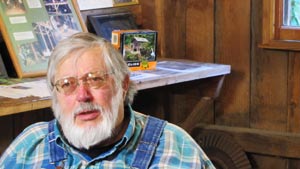It’s a national landmark, and the only working hydro-powered grist mill in Washington State. Built in 1876, The Cedar Creek Grist Mill, located in southwestern Washington, just outside the town of Woodland is situated above the banks of the Cedar Creek. The mill offers visitors a unique view into a by-gone era of community mills that once formed the foundation for local farm communities throughout the country.
Since the mill was restored to working order by “The Friends of the Cedar Creek Mill” during the 1980’s, the grist mill has become a working museum, supported entirely by visitor donations, and volunteers who run the mill for area school kids, and a regular flow of visitors who come from all over the world to see how an old-fashioned mill turns grain into flour.
As we learn from Tom Henrich, a volunteer who has become a “qualified miller” by helping run the mill since 2000, typically, mills of this sort operated on a shoestring budget. Their chief value, they provided vital services to local farmers that converted their grain into flour to feed their families, or processed grain to feed their animals. In lieu of money, the millers would often receive a 20% share of the grain for their processing services. The farmer would cart the remaining flour by wagon back home; a single journey of 15 miles might require 2-3 days of travel.
Henrich would one day like to see the mill upgraded to include a refurbished receiver separator that was lost in a barn fire, and grain storage bins installed on the upper level with transferring equipment so the mill could literally be run by one miller. According to Henrich, around 1805, Oliver Evans designed mills of this type where a single miller could “operate the thing and transfer the grain from one portion of the mill to another just by pulling a lever all operated by water power”.
Most of the videos featured on Cooking Up a Story were produced, filmed, and edited by Rebecca Gerendasy. Fred Gerendasy contributed as a writer to many of the posts and occasionally as the interviewer. Visit Rebecca Gerendasy Clay – Art and Fred Gerendasy Photography to see their current work.

